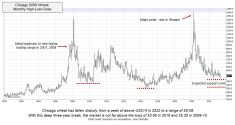Earlier in January, the corn and soybean futures market incorporated a risk premium due to the uncertainty in South American production. This risk premium in the market is eroding due to recent precipitation and favourable weather forecasts.
Quick look
Soybeans: Farmers were regular sellers throughout the price rally.
Corn: Ethanol demand for corn has declined due to high crop prices.
Wheat: Ontario planted wheat acreage is up 15 per cent.
Ontario elevator bid prices for old crop positions are down more than $1 per bushel from earlier in January. The world soybean market is transitioning from North American origin to South American origin.
Read Also

Scouting advised for soybean aphids
Soybean aphids have been spotted in a few fields in southern Ontario that haven’t seen soybean aphids in quite a…
The Brazilian harvest will begin in February and move into high gear during March. Soybean futures have dropped sharply due to fund long liquidation and softer export demand.
Ontario corn prices are relatively unchanged compared to the second week of January. Ethanol production has slowed in the short term due to the higher corn values. The export pace has also eased but still exceeds year-ago levels.
Ontario corn prices have held value better than soybeans because Brazil’s larger second safrinha corn crop will only be harvested in May and June. North American corn is still competitive on the world market.
Ontario wheat prices are marginally lower compared to earlier in January. The world wheat complex continues to digest the Russian wheat tariffs and Ukraine export controls.
The March Canadian dollar has been consolidating in the range of 78 U.S. cents and 79.5 U.S. cents.
World currency markets are adjusting to the fiscal policies of United States President Joe Biden’s administration. The increase in U.S. money supply and the potential rise in inflation continue to keep the U.S. dollar under pressure compared to all major currencies.
Higher crude oil and commodity prices in general has been independently supportive for the Canadian dollar versus the greenback.
Soybeans
Ontario soybean prices reached more than $17 per bushel earlier in January but at the time of writing this article, elevator bid prices were in the range of $16.10 to $16.40 per bushel.
Farmers have been regular sellers throughout the rally and we now find exporters and domestic crushers covered for their nearby requirements. The domestic crush pace appears to have slowed in the short term, while exports continue to exceed expectations.
Canadian crop-year-to-date soybean exports for the week ending Jan. 17 were 3.1 million tonnes, up from 2.1 million tonnes last year. Crop-year-to-date domestic usage was 853,900 tonnes, up from 764,500 tonnes last year. We continue to project a historically tight Ontario soybean carryout for the 2020-21 crop year.
The world soybean market is in transition. The U.S. Department of Agriculture projects the U.S. soybean carryout to finish near 3.8 million tonnes. However, it’s important to note that U.S. soybean export commitments are up 86 per cent from year-ago levels and reaching close to the USDA total projection of 61 million tonnes.
Private analysts forecast U.S. soybean ending stocks to drop under 2.7 million tonnes, which is historically tight. The low carry-out projection has the U.S. market rationing demand. Without going into detail, U.S. export offers out of the Gulf of Mexico are about a $12 to $15 premium to Brazilian origin for March shipment.
The Brazilian crop was planted a bit later and there will be some hiccups on export execution, however, these delays tend to work themselves out. It’s important to realize that the Brazilian crop was estimated at 133 million tonnes on the latest USDA World Agricultural Supply and Demand Estimates report, up from last year’s output of 126 million tonnes. The main point is that this is a record Brazilian crop.
The soybean market has likely defined the upside potential. Moving forward, rallies in the market will be selling opportunities.
What to do: The market is encouraging U.S. and Canadian farmers to increase acreage for 2021. We’ve advised Ontario farmers to be 80 per cent sold on the 2020 production and 20 per cent sold on new crop. In the previous issue, we recommended that farmers sell the final 20 per cent increment over the next 30 days and this appears to have been a timely recommendation. Unless we see crop problems in North America this spring, we believe it will be difficult for the soybean market to make fresh highs.
Corn
At the time of writing, Ontario elevator bids for corn were hovering around $6.35 per bushel, unchanged from the first week of January. The market is contending with slower export demand.
During December, Canadian corn exports during November were 143,100 tonnes; December exports were 257,000 tonnes but January exports will only finish near 15,000 tonnes. (Corn exports are mostly Ontario origin).
Secondly, demand from ethanol processors has evaporated due to poor margins. Cattle-on-feed inventories are at seasonal highs, but this isn’t sufficient to sustain the current price structure over the longer term. Ontario farmers have been active sellers over the past few weeks and domestic prices are expected to come under pressure moving forward.
March corn futures reached a high of $5.41 per bushel after the January WASDE report, but have since dropped under $5 per bushel. The USDA lowered the U.S. corn yield and production estimate while making downward revisions to the demand equation.
U.S. corn ending stocks are expected to finish near 39.4 million tonnes, down from the 2019-20 carryout of 48.8 million tonnes and down from the five-year average ending stocks of 51.4 million tonnes.
The USDA is looking for the market to ration demand. U.S. corn export sales commitments are still running 131 per cent above year-ago levels. U.S. offers out of the Gulf are most competitive on the world market until April.
The Argentine government lifted export restrictions, but farmers are concerned the government will increase the export tax. This has spurred Argentine farmer selling in the short term and the harvest will move into full swing in March. Brazil’s second crop corn comes on the market in May. Commercial traders are always trading two to four months forward, so U.S. export sales will slow down over the next month.
U.S. hard red winter wheat will move into feed channels in the southern plains once harvest begins in late May and June. This takes the edge off the feed usage for corn.
What to do: There is an old saying that the bull needs to be fed daily for the market to trade higher. The overall environment is not getting more bullish but rather neutralizing for the time being. We’ve advised Ontario farmers to be 60 per cent sold on their 2020 production. We’re advising producers to sell another 20 per cent of their 2020 crop, bringing total sales to 80 per cent.
Wheat
Ontario winter wheat prices are slightly lower compared to the first week of January.
In previous issues, we’ve mentioned that Ontario and U.S. soft red winter wheat supplies were expected to drop to historical lows at the end of the 2020-21 crop year. Ontario soft red winter wheat offers are competitive on the world market, which has kept domestic cash prices well-supported, despite the recent selloff in the futures market. At this stage, the world wheat market has likely factored in the Russian wheat tariffs and Ukraine export controls.
Looking forward, producers should remember that U.S. winter wheat harvest begins in late May and moves into high gear in June. We’re only about four months away from the start.
At this stage, it’s important to go over the seeded acreage. The world is going to produce more wheat in 2021. The USDA released its winter wheat seeding report earlier in January. U.S. soft red winter wheat acres were up 12 per cent over year-ago levels while hard red winter wheat acres were up four per cent.
European winter wheat acres are expected to be up seven per cent to eight per cent over year-ago levels. Early estimates have Russian winter wheat acres up one to two per cent.
According to Statistics Canada, Ontario farmers planted 1.162 million acres this fall, up 15 per cent from the fall of 2019. We’re only going to see decreases in Canadian and U.S. spring wheat acres but otherwise, Northern Hemisphere winter wheat acres are up from year-ago levels.
What to do: We’ve advised Ontario farmers to be 60 per cent sold on their 2020 production. We’re planning to make our next sale later in February, as companies start to prepare for lakes opening and shipping season. Our strategy is to make incremental sales from February through April. We want to have the crop sold by the time the U.S. harvest starts.















